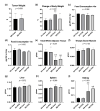The Effects of Prebiotic Supplementation with OMNi-LOGiC® FIBRE on Fecal Microbiome, Fecal Volatile Organic Compounds, and Gut Permeability in Murine Neuroblastoma-Induced Tumor-Associated Cachexia
- PMID: 32650568
- PMCID: PMC7400931
- DOI: 10.3390/nu12072029
The Effects of Prebiotic Supplementation with OMNi-LOGiC® FIBRE on Fecal Microbiome, Fecal Volatile Organic Compounds, and Gut Permeability in Murine Neuroblastoma-Induced Tumor-Associated Cachexia
Abstract
Malignant diseases can cause tumor-associated cachexia (TAC). Supplementation with prebiotic non-digestible carbohydrates exerts positive metabolic effects in experimental oncologic diseases. The aim of this project was to assess the effect of prebiotic supplementation with OMNi-LOGiC® FIBRE on intestinal microbiome, bacterial metabolism, gut permeability, and inflammation in a murine model of neuroblastoma (NB)-associated TAC. For this study, 2,000,000 NB cells (MHH-NB11) were implanted into athymic mice followed by daily supplementation with water or 200 mg prebiotic oligosaccharide (POS) OMNi-LOGiC® FIBRE (NB-Aqua, n = 12; NB-POS, n = 12). Three animals of each tumor group did not develop NB. The median time of tumor growth (first visibility to euthanasia) was 37 days (IQR 12.5 days) in the NB-Aqua group and 37 days (IQR 36.5 days) in the NB-POS group (p = 0.791). At euthanasia, fecal microbiome and volatile organic compounds (VOCs), gut permeability (fluorescein isothiocyanate-dextran (FITC-dextran), and gut barrier markers were measured. Values were compared to sham animals following injection of culture medium and gavage of either water or OMNi-LOGiC® FIBRE (SH-Aqua, n = 10; SH-POS, n = 10). Alpha diversity did not differ significantly between the groups. Principal coordinate analysis (PCoA) revealed clustering differences between Aqua and POS animals. Both NB and POS supplementation led to taxonomic alterations of the fecal microbiome. Of 49 VOCs, 22 showed significant differences between the groups. NB animals had significantly higher gut permeability than Aqua animals; POS did not ameliorate these changes. The pore and leak pathways of tight junctions did not differ between groups. In conclusion, our results suggest that NB-induced TAC causes increased gut permeability coupled with compositional changes in the fecal microbiome and VOC profile. Prebiotic supplementation with OMNi-LOGiC® FIBRE seemed to induce modifications of the fecal microbiome and VOC profile but did not improve gut permeability.
Keywords: gut permeability; microbiome; neuroblastoma; prebiotics; volatile organic compounds.
Conflict of interest statement
The authors declare no conflict of interest. The funders had no role in the design of the study; in the collection, analyses, or interpretation of data; in the writing of the manuscript; or in the decision to publish the results.
Figures






References
-
- Anker M.S., Holcomb R., Muscaritoli M., von Haehling S., Haverkamp W., Jatoi A., Morley J.E., Strasser F., Landmesser U., Coats A.J.S., et al. Orphan disease status of cancer cachexia in the USA and in the European Union: A systematic review. J. Cachexia Sarcopenia Muscle. 2019;10:22–34. doi: 10.1002/jcsm.12402. - DOI - PMC - PubMed
-
- Castellani C., Singer G., Kaiser M., Obermüller B., Warncke G., Miekisch W., Kolb-Lenz D., Summer G., Pauer T.M., Elhaddad A., et al. The Effects of Neuroblastoma and Chemotherapy on Metabolism, Fecal Microbiome, Volatile Organic Compounds and Gut Barrier-A Murine Model of Human Neuroblastoma. Ped. Res. 2019;85:546–555. doi: 10.1038/s41390-019-0283-1. - DOI - PubMed

